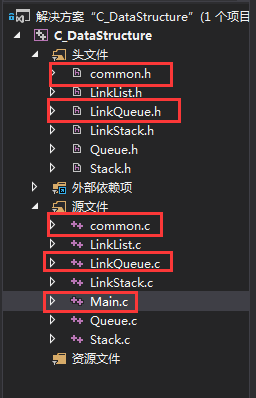工程目录结构图:

common.h:
1 //#ifndef __common_h__ 2 //#define __common_h__ 3 4 #define OK 1 5 #define ERROR 0 6 #define TRUE 1 7 #define FALSE 0 8 9 #define MAXSIZE 20 10 11 typedef int Status; //函数的返回结果,OK、ERREO、TRUE、FALSE 12 typedef int ElemType; //结点数据域的数据类型 13 14 //#endif
common.c:
1 #include "common.h" 2 3 Status visit(ElemType e) 4 { 5 printf("%d , ", e); 6 return OK; 7 }
LinkQueue.h:
1 //链队列结点结构 2 typedef struct QNode 3 { 4 ElemType data; 5 struct QNode *next; 6 }QNode, *QNodePtr; 7 8 //链队列,带有头结点 9 typedef struct 10 { 11 QNodePtr front, rear; 12 }LinkQueue;
LinkQueue.c:
1 #include <stdio.h> 2 #include <malloc.h> 3 #include "common.h" 4 #include "LinkQueue.h" 5 6 Status InitLinkQueue(LinkQueue *Q) 7 { 8 Q->front = Q->rear = (QNodePtr)malloc(sizeof(QNode)); 9 if (!Q->front) 10 return FALSE; 11 Q->front->next = NULL; 12 return OK; 13 } 14 15 Status LinkQueueEmpty(LinkQueue Q) 16 { 17 if (Q.front == Q.rear) 18 return TRUE; 19 else 20 return FALSE; 21 } 22 23 int GetLinkQueueLegth(LinkQueue Q) 24 { 25 int length = 0; 26 27 QNodePtr ptr = Q.front; 28 while (ptr != Q.rear) 29 { 30 ++length; 31 ptr = ptr->next; 32 } 33 34 return length; 35 } 36 37 Status EnLinkQueue(LinkQueue *Q, ElemType e) 38 { 39 QNodePtr ptr = (QNodePtr)malloc(sizeof(QNode)); 40 if (!ptr) 41 return ERROR; 42 ptr->data = e; 43 ptr->next = NULL; 44 45 Q->rear->next = ptr; //把新结点ptr赋值给原队尾结点的后继 46 Q->rear = ptr; //把新结点ptr设置为队尾结点 47 48 return OK; 49 } 50 51 52 Status DeLinkQueue(LinkQueue *Q, ElemType *e) 53 { 54 if (Q->front == Q->rear) 55 return ERROR; 56 QNodePtr ptr = Q->front->next; 57 *e = ptr->data; 58 59 Q->front->next = ptr->next; 60 if (ptr == Q->rear) 61 Q->rear = Q->front; 62 63 free(ptr); 64 return OK; 65 } 66 67 Status ClearLinkQueue(LinkQueue *Q) 68 { 69 if (Q->front == Q->rear) 70 return OK; 71 72 Q->rear = Q->front; 73 QNodePtr p, q; 74 p = Q->front->next; 75 Q->front->next = NULL; 76 77 while (p) 78 { 79 q = p; 80 p = p->next; 81 free(q); 82 } 83 84 return OK; 85 } 86 87 Status DestroyLinkQueue(LinkQueue *Q) 88 { 89 while (Q->front) 90 { 91 Q->rear = Q->front->next; 92 free(Q->front); 93 Q->front = Q->rear; 94 } 95 return OK; 96 } 97 98 Status GetLinkHead(LinkQueue *Q, ElemType *e) 99 { 100 if (Q->front == Q->rear) 101 return ERROR; 102 103 *e = Q->front->next->data; 104 return OK; 105 } 106 107 Status LinkQueueTraverse(LinkQueue Q) 108 { 109 QNodePtr ptr = Q.front->next; 110 while (ptr) 111 { 112 visit(ptr->data); 113 ptr = ptr->next; 114 } 115 116 return OK; 117 } 118 119 void LinkQueueStart() 120 { 121 LinkQueue Q; 122 123 if (OK == InitLinkQueue(&Q)) 124 printf(" 链队列初始化完成 "); 125 126 if (LinkQueueEmpty(Q)) 127 printf(" 链队列为空! "); 128 else 129 printf(" 链队列不为空,队列长度: %d ", GetLinkQueueLegth(Q)); 130 131 for (int i = 1; i <= 5; ++i) 132 EnLinkQueue(&Q, i); 133 134 printf(" 入队 1-5 后的队列长度: %d ", GetLinkQueueLegth(Q)); 135 136 LinkQueueTraverse(Q); 137 138 if (LinkQueueEmpty(Q)) 139 printf(" 链队列为空! "); 140 else 141 printf(" 链队列不为空,队列长度: %d ", GetLinkQueueLegth(Q)); 142 143 ElemType e; 144 GetLinkHead(&Q, &e); 145 printf(" 对头元素为: %d ", e); 146 147 DeLinkQueue(&Q, &e); 148 printf(" 对头出列: %d ", e); 149 150 printf(" 对头出列后的队列长度: %d ", GetLinkQueueLegth(Q)); 151 152 ClearLinkQueue(&Q); 153 printf(" 清空列后的队列长度: %d ", GetLinkQueueLegth(Q)); 154 155 DestroyLinkQueue(&Q); 156 printf(" 销毁队列后,Q.front= %u Q.rear= %u ", Q.front, Q.rear); 157 158 }
main.c:
1 int main() 2 { 3 //LinkListStart(); 4 //StackStart(); 5 //LinkStackStart(); 6 //StartQueue(); 7 LinkQueueStart(); 8 getchar(); 9 return 0; 10 }